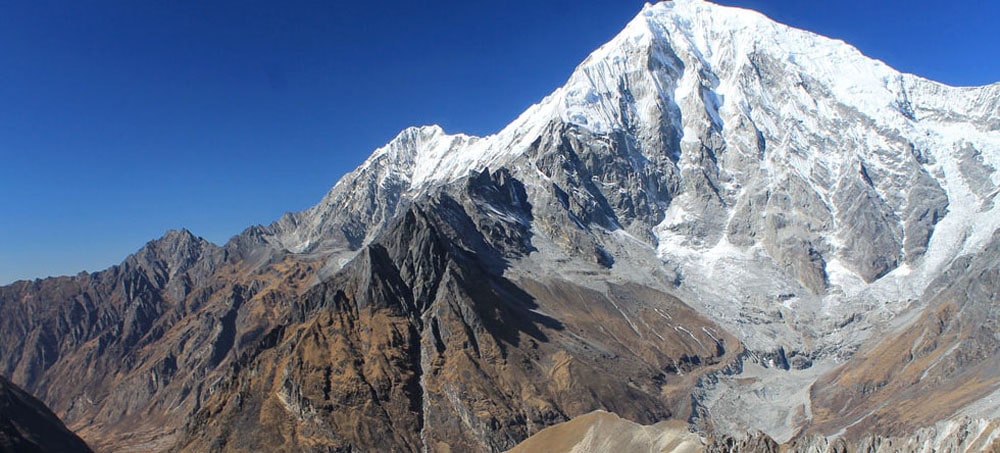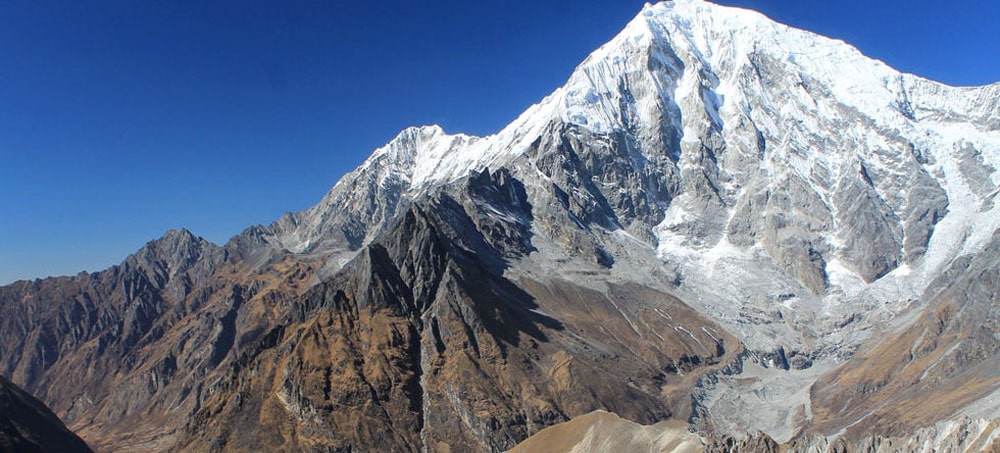
Image Credit: https://www.nepal-travel-guide.com/langtang-lirung-expedition/
Langtang Lirung At A Glance
Location: Langtang Himal subrange, Rasuwa District of Nepal
Elevation: 7,234 meters (23,734 feet)
Latitude: 28º 15′ 22
Longitude: 85º 31′ 10
1st ascent on: Oct 24,1978
1st ascent by: Seishi Wada, Pemba Tsering Sherpa
Nearest settlement: Kyangjing Gumba (10.1KM)
Langtang Lirung: An Introduction

Image Credit : https://www.himalayajourneys.com/mt-langtang-lirung-expedition.php
Are you planning a mountain limbing and trekking in Nepal? Is Langtang Lirung mountain expedition and Langtang valley trek on your bucket list? Do you want to learn in detail about this mysterious mountain?
Imagine a towering giant, Langtang Lirung, standing tall at 7,227 meters in the heart of the Himalayas, where Nepal meets Tibet. This breathtaking mountain, often hidden from the world’s gaze, is a symbol of both natural wonder and human determination.
For centuries, Langtang Lirung has been a revered landmark in the Langtang Valley, a place where nature’s beauty and cultural traditions entwine. Climbing this majestic peak is no ordinary feat; it demands not just physical strength but the spirit of adventure.
In this article, we uncover many facts of Langtang Lirung mountain. We’ll uncover its stunning landscapes, the rich heritage of the Langtang region, and the incredible challenges faced by mountaineers who dare to reach its summit.
Langtang Lirung Location
Langtang Lirung is positioned right on the border of Tibet, within the Langtang Himal subrange of the Himalaya. Within this region, there are a total of 14 primary peaks to be found. Among these peaks, just one stands at an elevation lower than 6,000 meters, while an impressive 11 peaks range between 6,000 and 6,999 meters. Notably, two of these peaks surpass the 7,000-meter mark: Langtang Ri, reaching an elevation of 7,205 meters, and the towering Langtang Lirung, which proudly stands at 7,227 meters.
Langtang National Park, founded in 1976, holds the distinction of being Nepal’s very first national park. This sanctuary is not only home to diverse natural wonders but also encompasses 26 charming villages, including the picturesque Langtang Valley. The Trishuli and Bhote Koshi Rivers serve as natural links between the western and eastern parts of the park, while to the south, its boundary is approximately 30 kilometers north of the vibrant Kathmandu Valley.
A Dangerous Mountain to Conquer
Langtang Lirung is a mountain that’s really tough to climb, and not many people try. Out of 51 groups that tried to reach the top, only 14 made it. The last time someone succeeded was in 2010.
Among those 14 groups, 54 climbers managed to stand on the summit, but it came at a cost. Sadly, 16 climbers lost their lives while trying. Three of them had reached the top before the accidents happened. Most of the accidents were because of avalanches, which are like big snow slides. Falling rocks and ice caused two deaths, and one climber fell and later died. One of the famous climbers who died on this mountain was Tomaz Humar in 2009.
This mountain is so challenging that even the teams that guide climbers on other mountains don’t go here. Also, none of the climbers who attempted Langtang Lirung used extra oxygen to help them breathe in the thin air up there.
The first ascent: 1978
In 1978, something remarkable happened in Langtang Lirung. A team from Osaka City University, led by Akira Ban and joined by two skilled climbers from Tribhuvan University, set out to conquer this challenging mountain. Their journey began by trekking through the Langtang Glacier, and their goal was to climb up the east ridge of the mountain. They had three experienced Sherpas to assist them on this challenging adventure.
After weeks of hard work and determination, on October 15, the Japanese team reached Camp 2, which was located at an altitude of 5,710 meters. Four days later, they pushed on to establish Camp 3 at 6,280 meters. Continuing their slow but steady ascent, they set up Camp 4 on October 22 on the southeast glacier at an impressive height of 6,800 meters. This was the starting point for their final push to the summit.
Their efforts paid off when, on that challenging journey to the top, two climbers achieved the ultimate goal. Seishi Wada reached the summit at 9:25 am, and just two minutes later, Pemba Tsering Sherpa joined him there. It was a momentous achievement in the history of Langtang Lirung.
A Sample 35 Days Mt. Langtang Lirung Expedition Itinerary
The “Mt. Langtang Lirung Expedition” is a challenging and ambitious mountaineering adventure that takes climbers to the stunning Langtang Lirung peak. This expedition offers a rare opportunity to tackle one of the formidable giants of the Himalayas.
Langtang Lirung, standing at a towering altitude of 7,227 meters (23,711 feet), presents a formidable challenge to climbers due to its steep and rugged terrain, avalanches, and unpredictable weather. Successfully reaching its summit is an achievement that demands not only physical strength but also exceptional mountaineering skills, endurance, and a deep understanding of the mountain’s risks and rewards.
Here is a sample itinerary of 35 days Mount Langtang Lirung expedition itinerary:
Day 1: Arrival in Kathmandu
Arrive in Kathmandu, Nepal.
Meet with expedition team and briefing.
Day 2: Kathmandu Sightseeing and Preparation
Explore Kathmandu’s cultural heritage.
Gear and equipment check.
Expedition preparation.
Day 3: Drive to Syabrubesi
Scenic drive to Syabrubesi, the gateway to Langtang Valley.
Overnight in Syabrubesi.
Day 4: Trek to Lama Hotel
Start trekking towards Lama Hotel.
Trek through lush forests and charming villages.
Overnight in Lama Hotel.
Day 5: Trek to Langtang Village
Continue trekking to Langtang Village.
Enjoy panoramic mountain views.
Overnight in Langtang Village.
Day 6: Trek to Kyanjing Gompa
Trek to Kyanjing Gompa, a picturesque mountain village.
Explore the Tibetan monastery and surrounding area.
Overnight in Kyanjing Gompa.
Day 7: Acclimatization and Rest
Rest day for acclimatization.
Short hikes to nearby viewpoints.
Overnight in Kyanjing Gompa.
Day 8: Trek to Langtang Lirung Base Camp
Begin the approach to Langtang Lirung Base Camp.
Trek through rugged terrain.
Overnight at Base Camp.
Day 9-28: Langtang Lirung Summit Attempts
Days dedicated to summit attempts and acclimatization climbs.
Climbers make multiple camps at higher altitudes.
Navigate challenging terrain and weather conditions.
Summit bid.
Day 29: Descend to Base Camp
Descend from high camps to Langtang Lirung Base Camp.
Rest and recovery.
Day 30: Return to Kyanjing Gompa
Trek back to Kyanjing Gompa.
Celebrate the expedition’s achievements.
Overnight in Kyanjing Gompa.
Day 31: Trek to Lama Hotel
Descend to Lama Hotel.
Reflect on the expedition’s challenges and successes.
Overnight in Lama Hotel.
Day 32: Trek to Syabrubesi
Continue trekking to Syabrubesi.
Farewell to the Langtang region.
Overnight in Syabrubesi.
Day 33: Drive to Kathmandu
Drive back to Kathmandu.
Rest and relaxation in the city.
Overnight in Kathmandu.
Day 34: Kathmandu
Free day in Kathmandu for shopping and sightseeing.
Celebration dinner with the expedition team.
Day 35: Departure
Departure from Kathmandu or extend your stay for further exploration.
FAQs
Langtang Mountain, or more precisely Langtang Lirung, is located on the border of Tibet and Nepal, within the Langtang Himal subrange of the Himalayan mountain range. It is southwest of Shishapangma.
The Langtang village in Nepal suffered a tragic loss during the devastating earthquake that struck Nepal in April 2015. It is estimated that approximately 300 people lost their lives when Langtang village was buried by a massive avalanche triggered by the earthquake. This event was a significant tragedy for the local community and trekkers in the area.
Langtang village was destroyed due to a powerful earthquake that struck Nepal on April 25, 2015. The earthquake, with a magnitude of 7.8, triggered a massive avalanche that swept down the mountainside, burying the village under tons of snow and debris. The combination of the earthquake and the subsequent avalanche led to the destruction of Langtang village.
Langtang Valley is famous for its breathtaking natural beauty, including stunning landscapes, lush forests, picturesque villages, and majestic mountains. It is a popular trekking destination in Nepal, known for its scenic trekking routes and the opportunity to experience the local Tamang culture. Additionally, Langtang Valley is the gateway to Langtang National Park, which is home to diverse flora and fauna, making it a haven for nature enthusiasts and wildlife lovers.